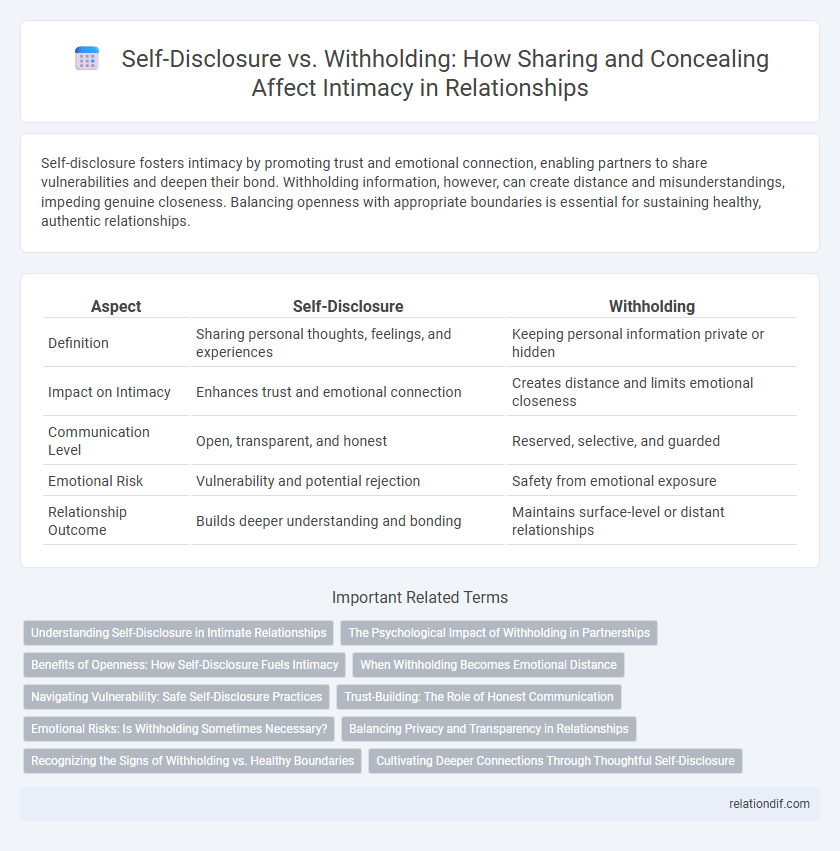Self-disclosure fosters intimacy by promoting trust and emotional connection, enabling partners to share vulnerabilities and deepen their bond. Withholding information, however, can create distance and misunderstandings, impeding genuine closeness. Balancing openness with appropriate boundaries is essential for sustaining healthy, authentic relationships.
Table of Comparison
| Aspect | Self-Disclosure | Withholding |
|---|---|---|
| Definition | Sharing personal thoughts, feelings, and experiences | Keeping personal information private or hidden |
| Impact on Intimacy | Enhances trust and emotional connection | Creates distance and limits emotional closeness |
| Communication Level | Open, transparent, and honest | Reserved, selective, and guarded |
| Emotional Risk | Vulnerability and potential rejection | Safety from emotional exposure |
| Relationship Outcome | Builds deeper understanding and bonding | Maintains surface-level or distant relationships |
Understanding Self-Disclosure in Intimate Relationships
Understanding self-disclosure in intimate relationships involves recognizing the balance between revealing personal thoughts and emotions and the decision to withhold certain information to maintain boundaries. Effective self-disclosure fosters trust, emotional closeness, and mutual understanding, while excessive withholding can lead to misunderstandings and emotional distance. Research in psychology highlights that timely and appropriate sharing of vulnerabilities significantly strengthens intimacy and relationship satisfaction.
The Psychological Impact of Withholding in Partnerships
Withholding self-disclosure in partnerships can lead to increased emotional distance, fostering misunderstandings and eroding trust between partners. Psychological impacts include heightened anxiety, feelings of isolation, and reduced intimacy, which undermine relationship satisfaction. Consistent concealment disrupts the development of emotional safety essential for healthy, supportive connections.
Benefits of Openness: How Self-Disclosure Fuels Intimacy
Self-disclosure fosters emotional closeness by creating trust and deepening understanding between partners, which strengthens intimacy. Open communication enables vulnerability, allowing individuals to share authentic thoughts and feelings that build connection and empathy. Consistent self-disclosure reduces misunderstandings and supports long-term relational satisfaction by promoting transparency and mutual support.
When Withholding Becomes Emotional Distance
Withholding personal thoughts and feelings in intimacy often creates emotional distance that hinders genuine connection and trust between partners. Consistent self-disclosure fosters vulnerability, deepening emotional bonds, whereas withholding can lead to misunderstandings and feelings of isolation. Emotional distance grows when partners avoid sharing, causing relational dissatisfaction and reduced intimacy over time.
Navigating Vulnerability: Safe Self-Disclosure Practices
Navigating vulnerability through safe self-disclosure practices involves balancing honesty with emotional boundaries to foster trust without risking harm. Prioritizing gradual sharing in secure environments enhances emotional intimacy while minimizing exposure to judgment or rejection. Understanding personal limits and recognizing trustworthy confidants are essential for maintaining psychological safety during self-disclosure in intimate relationships.
Trust-Building: The Role of Honest Communication
Honest communication fosters trust-building by promoting transparency and vulnerability through self-disclosure, which allows partners to understand each other's true feelings and intentions. Withholding information, conversely, can create barriers, increasing suspicion and emotional distance, impeding intimacy development. Consistent openness enhances emotional safety, reinforcing a foundation of mutual respect and reliability in intimate relationships.
Emotional Risks: Is Withholding Sometimes Necessary?
Withholding information in intimate relationships can serve as a protective mechanism against emotional risks such as vulnerability, rejection, or judgment. Self-disclosure fosters trust and connection, but excessive openness without discernment may lead to emotional harm or imbalance. Balancing transparency with selective withholding allows individuals to maintain personal boundaries while nurturing intimacy.
Balancing Privacy and Transparency in Relationships
Balancing privacy and transparency in relationships requires navigating self-disclosure and withholding carefully to maintain trust without sacrificing personal boundaries. Research shows that selective self-disclosure strengthens intimacy by fostering emotional connection while preserving individual autonomy. Effective communication strategies prioritize honesty and timing, enabling partners to share meaningful information yet protect sensitive aspects of their personal lives.
Recognizing the Signs of Withholding vs. Healthy Boundaries
Recognizing the signs of withholding involves noting patterns of avoidance, evasive communication, and emotional distance that hinder genuine connection. Healthy boundaries, in contrast, are marked by clear, respectful limits that promote trust and mutual understanding without creating barriers. Differentiating between these allows individuals to foster intimacy while protecting personal well-being.
Cultivating Deeper Connections Through Thoughtful Self-Disclosure
Thoughtful self-disclosure fosters intimacy by encouraging vulnerability and trust, enabling deeper emotional connections. Balancing openness with appropriate boundaries helps individuals share meaningful experiences while protecting personal privacy. This deliberate sharing promotes empathy and mutual understanding, strengthening relational bonds over time.
self-disclosure vs withholding Infographic

 relationdif.com
relationdif.com